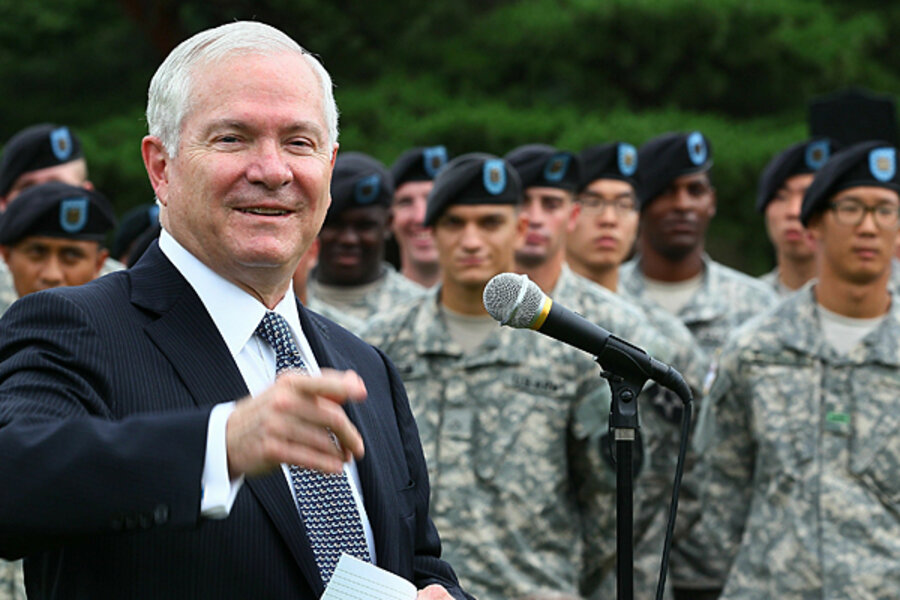USS George Washington, S. Korea military drills send mixed signals to North Korea
Loading...
The United States is sending mixed signals to North Korea, China – and also South Korea – in a display of high-level solidarity with the South that includes one of the biggest displays of military might in the region in recent years.
The two US cabinet members with the greatest influence on US policies overseas, Defense Secretary Robert Gates and Secretary of State Hillary Rodham Clinton, are seeing their counterparts in Seoul on Wednesday to fortify an alliance that at times has appeared weak and vacillating.
Officials have dubbed the meetings the “two plus two” talks, the first time the Defense secretary and secretary of State have descended upon Seoul simultaneously, and they’ve already begun pouring out statements and messages on the enduring strength of the alliance. The most dramatic signal will be military exercises, led by the aircraft carrier George Washington, that Mr. Gates and Korea’s defense minister, Kim Tae-young, say are “designed to send a clear message to North Korea that its aggressive behavior must stop.”
Response to sinking of South Korean Navy ship
The whole show amounts to a minutely orchestrated response to North Korea’s sinking of the South Korean Navy corvette the Cheonan in March in which 46 sailors were killed. The exercises, featuring 20 US and South Korean ships and 200 warplanes, are slated to go on for four days – but in waters nowhere near where the Cheonan went down in the Yellow Sea.
Instead, in a bow to strenuous objections from China, they’ll take place in what Koreans call the East Sea, a name on which they strongly insist on instead of "The Sea of Japan" as it's called elsewhere.
The need to use a “neutral” term for those waters became clear last week after a Pentagon official, announcing plans for the exercises, raised eyebrows in Seoul by saying they would be held in “the Sea of Japan.” US officials subsequently said that all statements will refer to waters “off the east coast” – a turn of phrase that is critical if the Americans are to avoid a chorus of criticism from South Korean officials, political figures, and the media.
Raised eyebrows
On a much larger scale, the exercises are finally going to happen after weeks of uncertainty in which South Korea’s Defense Ministry pressed the Americans to stage them in the Yellow Sea as a show of force against North Korea.
“There is a difference between the South Korean and US position,” says Paik Hak-soon, senior fellow at the Sejong Institute, an influential Korean think tank. “The US will try to persuade South Korea to being more realistic, and the South Korean government will try to persuade the US to be more cooperative.”
On Wednesday, deep cooperation, friendship, and mutual support will be the themes of the day in which Gates and Mrs. Clinton are supposed to lay wreaths at the South Korean war memorial and visit the demilitarized zone that has divided North and South Korea since the end of the Korean War. Not a whisper of differences is likely to be heard emerging from meetings that will also feature a supporting cast including Adm. Mike Mullen, chairman of the US joint chiefs of staff, and Adm. Robert Willard, chief of the US Pacific command.
Also on hand will be two other senior officials, Assistant Secretary of State Kurt Campbell and Sung Kim, the US nuclear negotiator. They in particular will want to look beyond Wednesday’s meetings to the possibility of resuming six-party talks on North Korea’s nuclear program after the exercises are done.
The meetings Wednesday will deal with “how to promote alliance cooperation and how to get out of the Cheonan incident politics,” says Mr. Paik. He predicts “some disagreement” between the US and South Korea “in determining how early to return to six-party talks,” last held in Beijing in December 2008.
How about China?
As for holding the exercises off the east coast rather than in the Yellow Sea, Paik believes “China will accept it as a compromise and a smart move.”
At the same time, the whole display is intended to allay South Korean concerns ranging from doubts about the future of the alliance to leftist protests against what some see as a show that’s likely to increase tensions.
Building up goodwill, the USS George Washington is mooring this week at the South Korean port of Pusan and hosting tours of journalists, VIPs, and citizen groups, including orphans. Three destroyers with Aegis countermissile systems will also be in Pusan and also in Chinhae, the port off the southern coast that is the headquarters for US and South Korean naval operations.
“It’s good public relations for the South Koreans,” says an official at the US military headquarters here. “It’s to show force and build up relationships.”
South Korean experts agree.
“Basically, it’s to show power to North Korea,” says Kim Tae-woo at the Korea Institute for Defense Analyses. “It seems to be diluted by moving the exercises from the Yellow Sea, but politically it’s a very important event, and we welcome it.”
“At this moment,” he asked rhetorically, considering China’s qualms about exercises in the Yellow Sea, which borders China, “what else can we expect?”
Related:





